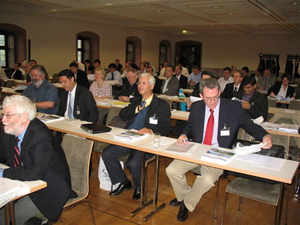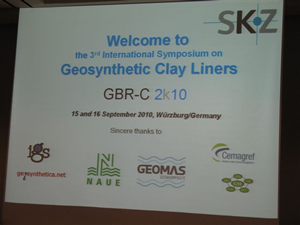 |
Day two in Würzburg, Germany and day one of the 3rd International Conference on Geosynthetic Clay Liners was excellent. Yet again while we met inside Würzburg’s historic Fortress Marienberg, the The Three Musketeers remake went on filming in the adjacent building, which is to serve, ostensibly, as Paris. Nevertheless, Kerry Rowe (Queens University, Canada) and Craig Benson (University of Wisconsin, USA) gave excellent keynote lectures.
Kerry presented his work on geomembrane wrinkle development and the need to cover the liner early in the morning or late in the afternoon to avoid liner stresses and to achieve the desired geomembrane/GCL intimate contact. Kerry considers wrinkles over 30 mm high to be “significant” wrinkles.
It was suggested (not by Kerry) that large wrinkles could perhaps be compressed and folded over to regain lost contact area, but stress cracking considerations made this a no-no!
Craig graphically demonstrated the need to rapidly hydrate a GCL and to keep it hydrated without hydration/dehydration cycles. He identified some of the performance criteria of laminated or composite geosynthetic clay liners (GCLs) incorporating a thin film. On a similar note earlier in the day, I had presented some of the pros and cons of placing such a composite GCL with the film up or down.
 |
Prof. El-Zein (University of Sydney, Australia) initiated extensive discussion upon saying that modeling was not intended to predict reality! Subsequently, most saw his point of view.
Rick Thiel (Thiel Engineering, USA) brought us up to date on the loss of GCL overlaps under exposed geomembranes, suggesting that heat tacking the overlap may be sufficient to prevent such separation.
Finally, Dr. Soltys (PTH Intermark, Poland) intrigued us with his thoughts on adding nanoparticles of Halloysite to Montmorrilonite to retain monovalent sodium ions and to prevent/minimize their exchange by divalent cations, such as calcium.
In the evening, we moved over and down into the wine cellars of The Residence for a cheese/meat plate (incidental) while tasting seven Franconian white wines–the main business of the evening!
A great event so far; and, after a good walk back to the hotel, I was still able to write this at 1:00 am.
More tomorrow.
For Ian Peggs’ report of his arrival in Würzburg, Germany for the 3rd International Conference on Geosynthetic Clay Liners and his visit to the SKZ laboratory, see this article.
Ian D. Peggs is president of I-CORP International. He can be reached at icorp@geosynthetic.com.











